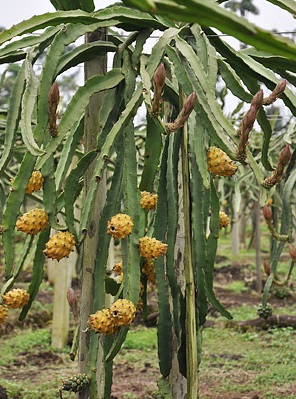New Account | Seed Mix |
Gift Certificates |AAS Winners |
Gardening Products
SEEDS: Unusual | Annuals | Perennials | Vegetables | Herbs | Trees
Yellow Pitaya Dragonfruit Seeds

D9917 Yellow Pitaya, Yellow Dragon Fruit ( Hylocereus megalanthus )
This rare cactus fruit has a unique sweet flavor. The seeds are slightly larger than most dragonfruit, and the inside fruit is extremely sweet and juicy!
Yellow Dragon fruit have an oblong shape and are slightly smaller in size than the more common red varieties. Their thick yellow skin is covered in small knobby protrusions, which when immature displays small spines that will naturally fall off as the fruit matures. Beneath the skin is a dense white flesh containing numerous petite, edible black seeds. Yellow Dragon fruit has a crisp, juicy texture and very sweet, tropical flavor with floral hints and no acidity.
Yellow Dragon fruit is typically eaten raw, either straight out of the skin or scooped out and cubed, balled or sliced. For the best flavor, refrigerate the fruit for 2 hours before preparing raw. Add to tropical fruit salads or serve alone as dessert. Yellow Dragon fruit flesh can be pureed and made into a sauce or syrup or added to smoothies and cocktails. Freeze the pureed pulp for sorbet or a granitas. Use the flesh to flavor pastries or other baked goods. Yellow Dragon fruit can be kept at room temperature for a few days and will keep in the refrigerator for up to a week.
The Yellow Dragon fruit has been used for centuries by the native people of northern South America. It was used for both medicinal and culinary purposes. It has only been since the early 2000s that Yellow Dragon fruit was approved for export to North America and Europe.
It is native to the northern region of South America, what is now Colombia and Ecuador. The fruits are still cultivated there, with Colombia being the largest producer, and are exported all over the world. They are also grown in Bolivia, Peru, and Mexico and in California and Florida in the United States. Growers specializing in rare fruits in the United States, specifically in southern California and Florida, grow Yellow Dragon fruit on a smaller scale. The Yellow Dragon fruit cactus has long extending stems that can grow up to 20 feet long and require some form of trellising or support to grow on. The cactus prefers arid tropical and subtropical climates and is fairly heat resistant and somewhat cold-hardy. Yellow Dragon fruits can be spotted at most markets and specialty stores and at farmer’s markets in Southern California and Florida.
Zones 10 and higer outside, can be grown inside in cooler zones if good light provided.
Yellow Dragon fruit have an oblong shape and are slightly smaller in size than the more common red varieties. Their thick yellow skin is covered in small knobby protrusions, which when immature displays small spines that will naturally fall off as the fruit matures. Beneath the skin is a dense white flesh containing numerous petite, edible black seeds. Yellow Dragon fruit has a crisp, juicy texture and very sweet, tropical flavor with floral hints and no acidity.
Yellow Dragon fruit is typically eaten raw, either straight out of the skin or scooped out and cubed, balled or sliced. For the best flavor, refrigerate the fruit for 2 hours before preparing raw. Add to tropical fruit salads or serve alone as dessert. Yellow Dragon fruit flesh can be pureed and made into a sauce or syrup or added to smoothies and cocktails. Freeze the pureed pulp for sorbet or a granitas. Use the flesh to flavor pastries or other baked goods. Yellow Dragon fruit can be kept at room temperature for a few days and will keep in the refrigerator for up to a week.
The Yellow Dragon fruit has been used for centuries by the native people of northern South America. It was used for both medicinal and culinary purposes. It has only been since the early 2000s that Yellow Dragon fruit was approved for export to North America and Europe.
It is native to the northern region of South America, what is now Colombia and Ecuador. The fruits are still cultivated there, with Colombia being the largest producer, and are exported all over the world. They are also grown in Bolivia, Peru, and Mexico and in California and Florida in the United States. Growers specializing in rare fruits in the United States, specifically in southern California and Florida, grow Yellow Dragon fruit on a smaller scale. The Yellow Dragon fruit cactus has long extending stems that can grow up to 20 feet long and require some form of trellising or support to grow on. The cactus prefers arid tropical and subtropical climates and is fairly heat resistant and somewhat cold-hardy. Yellow Dragon fruits can be spotted at most markets and specialty stores and at farmer’s markets in Southern California and Florida.
Zones 10 and higer outside, can be grown inside in cooler zones if good light provided.
For over a thousand more unique seed varieties, all in stock and ready to ship, visit our Seed Catalog Index Page .

